|
Early Risers
Lupins have been grown in British gardens for decades, but they still deserve a place, for their densely-packed, pepper-scented flowers arrive in May when most perennials are still sleeping on the job. Each dense, conical flower spike is tipped in green so these late-spring flowers (and their finger-like foliage) catch the spirit of a season when new leaf abounds. Seed-raised lupins include the shorter Gallery Series. ‘Gallery Blue’ should put out about ten flower spikes, and its shorter stature (50cm or so), allows it to slot into small gardens, or be used in front of the border.
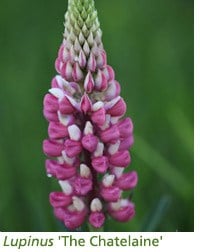 The Band of Nobles Series features taller lupins that rise to around 1.2m. The lucid-yellow ‘Chandelier’ will light up the spring garden. Or you could opt for the elegant white ‘Noble Maiden’, which is so good in dappled shade, or the pink and white ‘The Chatelaine’. Or you could mingle all three together. ‘Persian Slipper’, recently bred by Westcountry Nurseries, has lagoon blue flowers that show a hint of white, along with lots of green in the buds. This particularly spring-fresh combination of blue, white and green also arises in the spring-flowering alpina clematis, ’Frances Rivis’. The Band of Nobles Series features taller lupins that rise to around 1.2m. The lucid-yellow ‘Chandelier’ will light up the spring garden. Or you could opt for the elegant white ‘Noble Maiden’, which is so good in dappled shade, or the pink and white ‘The Chatelaine’. Or you could mingle all three together. ‘Persian Slipper’, recently bred by Westcountry Nurseries, has lagoon blue flowers that show a hint of white, along with lots of green in the buds. This particularly spring-fresh combination of blue, white and green also arises in the spring-flowering alpina clematis, ’Frances Rivis’.
Lupins produce seedpods, but these should be removed early on to keep the vigour in the mother plant. Slugs also favour the young foliage, which emerges early, so be vigilant. Other than that, lupins are easily grown on reasonably freely draining garden soil in mixed borders. Don’t feed them because, like many legumes, lupins prefer poorer conditions.
Amber, Peach and Gold

Verbascums relish dry conditions and summer sun and the grey-leaved shorter ones with peachy or pink flowers tend to be sterile. With no unwanted seedlings, you can leave the head intact to form a silhouette. They work well in gravel in minimalistic planting schemes, or in sun-drenched borders with lots of silver-grey foliage. Heights vary and the shoulder high ‘Clementine’ can top 1.5m. The buds, which resemble small green pincushions, open to sunset-yellow and peach and this colour contrasts with the purple furry filaments that all verbascums have. ‘Cotswold Queen’ is shorter with a multi-headed stem of ochre-yellow to amber petals set round the dark smudge and purple filaments. These golden, earthy colours are in short supply in early summer and the purple filaments are a real bonus. They allow you to use them with cool blues, pinks and purples. No wonder they are beloved by garden designers. Always look at the detail in every flower and match into that, not the main colour.

You can get the same glimmering gold effect and good vertical silhouettes from some of the perennial foxgloves such as Digitalis parviflora. Sometimes called the rusty foxglove, these look best massed together. The slender spires are packed with small silver-lipped cinnamon brown flowers that show some yellow. They give an almost tropical feel and mix well with grasses including the shimmering golden-awned, oat grass Stipa gigantea. The smaller-flowered salmon-pink ‘Glory of Roundway’ is another foxglove that offers a long-term presence, but this is mostly sterile. Both will rise to about a metre in height. The smaller, almost emaciated Digitalis lutea, is slightly shorter, and it will add sunbeams to a shadier patch - in the same way that Aquilegia chrysantha 'Yellow Queen’, a fragrant pallid-yellow columbine with long swept-back petals, does.
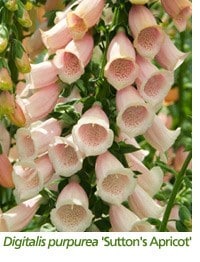 Biennial foxgloves are normally planted one year for next year’s flower but the new Dalmatian Series, named for their spotted flowers, flower in their first year on compact plants that reach only 60cm in height. ‘Dalmatian Purple’, which is new, has more-outward facing flowers so it will resemble an overblown hardy orchid. Taller biennial foxgloves include ‘Sutton’s Apricot’, which is sensational in semi-shade with blue campanulas. ‘Pam’s Choice’ is a white with cherry spots, and this would go very well with a moody rose such as ‘Charles de Mills’. All pink-flowered tapering tall foxgloves mix well with billowing old-fashioned roses, flowering at the same time. Remove the foxglove seed heads in mixed planting. If you leave them to self seed, be aware that the seeds will only germinate when the light hits them, so you may have to disturb the soil to get germination. The Dalmatian Series and forms of D. purpurea (such as ‘Sutton’s Apricot’) will usually die after they have finished flowering. Biennial foxgloves are normally planted one year for next year’s flower but the new Dalmatian Series, named for their spotted flowers, flower in their first year on compact plants that reach only 60cm in height. ‘Dalmatian Purple’, which is new, has more-outward facing flowers so it will resemble an overblown hardy orchid. Taller biennial foxgloves include ‘Sutton’s Apricot’, which is sensational in semi-shade with blue campanulas. ‘Pam’s Choice’ is a white with cherry spots, and this would go very well with a moody rose such as ‘Charles de Mills’. All pink-flowered tapering tall foxgloves mix well with billowing old-fashioned roses, flowering at the same time. Remove the foxglove seed heads in mixed planting. If you leave them to self seed, be aware that the seeds will only germinate when the light hits them, so you may have to disturb the soil to get germination. The Dalmatian Series and forms of D. purpurea (such as ‘Sutton’s Apricot’) will usually die after they have finished flowering.
 Delphiniums also mix well with roses and they come in true blues. The Summer Skies Group is a powder-blue with green eyes. The Astolat Group, which is around 1.8m in height when happy, has a green eye but the flowers are lilac-pink. ‘Centurion White’ is a cool mix of green and white. They will make bold statements in a border. Delphiniums emerge early and attract the slugs, so do be vigilant, and they also need staking. Canes and string are best and the optimum moment is when the plant gets to two thirds of its size. This is the golden rule for all staking, as then it doesn’t show! Delphiniums also mix well with roses and they come in true blues. The Summer Skies Group is a powder-blue with green eyes. The Astolat Group, which is around 1.8m in height when happy, has a green eye but the flowers are lilac-pink. ‘Centurion White’ is a cool mix of green and white. They will make bold statements in a border. Delphiniums emerge early and attract the slugs, so do be vigilant, and they also need staking. Canes and string are best and the optimum moment is when the plant gets to two thirds of its size. This is the golden rule for all staking, as then it doesn’t show!
You can get a blast of true blue using veronicas too. The shorter (30cm) ones make great front of border plants supported by other greenery and Stipa tenuissima does the job well when mingling with Veronica spicata ‘Royal Candles’. Bright green toothed foliage supports bright blue fuzzy spires, topped in green, creating a vibrant splash in the first part of summer. The taller Veronica longifolia 'Marietta' (PBR) is more purple than blue and the spires are arranged in a short upright candelabra on a taller plant reaching one metre. Deadhead this and more flowers will follow. You’ll get a similar height from the bright-pink loosestrife, Lythrum virgatum 'Dropmore Purple’, which produces willowy spires. Its black stems and reddened foliage adds to its allure. All of these flatter pink roses and usefully flower after the first flush.
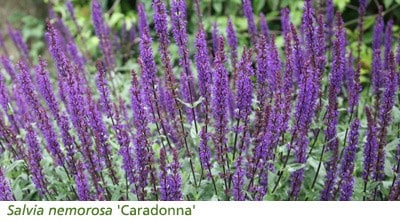
You could also try to find room for two blue-flowered spikes. Salvia nemorosa ‘Caradonna’ shares the same dark stems and touches of black so it glows in midsummer sun, for this flowers in July and then keeps on going. It clashes wonderfully well with orange crocosmias - and don’t forget that sword-shaped crocosmia foliage will also provide vertical accents. The burnished flowers of C.masoniorum would also flower at the same time as ‘Caradonna’. Don’t shun orange. It's a colour that should be used with blues and purples to create a floral explosion. Agastache ‘Black Adder’ has a softer bottle brush than the salvia, but it shares the same black and purple-blue colouring. It has a fuzzy outline that catches the sun too.
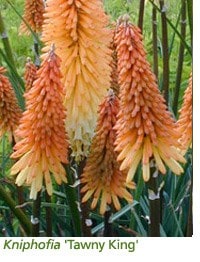 I’d sneak in a Kniphofia or two and if you’re too reluctant to add bright orange. You could go for the caramel and cream tones of Kniphofia ‘Tawny King’ a 1.2m high poker in sunset colours. Use this with the blue-black Salvia nemorosa ‘Caradonna' and Achillea ‘Terracotta’ for an eye-pleasing combination. You could also add a splash of mischief using the purple-pink feathery heads of Liatris spicata ‘Kobold’, one of the most butterfly-pleasing plants. I’d sneak in a Kniphofia or two and if you’re too reluctant to add bright orange. You could go for the caramel and cream tones of Kniphofia ‘Tawny King’ a 1.2m high poker in sunset colours. Use this with the blue-black Salvia nemorosa ‘Caradonna' and Achillea ‘Terracotta’ for an eye-pleasing combination. You could also add a splash of mischief using the purple-pink feathery heads of Liatris spicata ‘Kobold’, one of the most butterfly-pleasing plants.
When late-summer beckons the willowiest spires belong to Veronicastrum virginicum ‘Fascination’ which can reach 1.8m. The lilac-blue flowers persist for many weeks, blending with earlier asters such as A. x frikartii ‘Mönch'. Veronicastrums will also contrast with orange and yellow daisies whether it’s Helianthus ‘Lemon Queen’, or Helenium ‘Waltraut’. ‘Fascination’ has a fascinating habit of distorting its flowers into flattened shapes that resemble fish tails, a process known as fasciation.
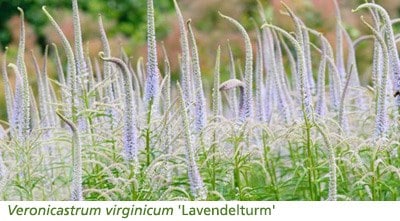
I have often wondered whether ‘Fascination’ is a play on words. ‘Lavendelturm’ is daintier, producing tapering lavender-pink flowers that rise from good green foliage. It’s very elegant and when the flowers brown it’s possible to rub off the jaded petals to reveal a green taper, which can be left throughout winter should you wish - for verticals are just as useful once the flowers fade. Finally, I also recommend the vibrant purple mallow, Malva sylvestris var. mauritiana for its dazzling pinpricks of purple in late-summer. It’s an electric, willowy plant that can be grown among Verbena bonariensis.
|
Five things to do
 |
Trim back penstemons etc.
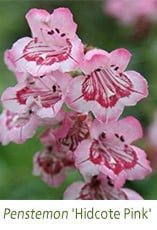
Cut back penstemons at the beginning of the month so that the new growth is compact. It’s also a good time to plant new penstemons too. You can also cut back some Mediterranean herbs now including sages and thymes, to keep them compact, and any other ragged plants such as dianthus. Don’t cut rosemary back however. Just tidy up any brown frost damage.
|
 |
Divide late-flowering perennials

Once the new growth is surging away, split up asters, heleniums and any other late-flowering perennials. Ideally the new growth should be about 7cm high. You can either replant them straight into the ground, or place them in pots. Do water them well though.
|
 |
Get on Top of Slugs
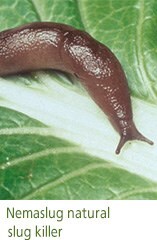
Late-april is the best time to water on nematodes for slug control, in selected areas. Choose a damp warm afternoon, mix according to instructions and water on. You won’t see lots of dead slugs on the surface, because it all goes on underground, but you will have fewer slugs.
|
 |
Protect Your Strawberries

The nights are still cold so cover strawberry flowers with fleece if a cool night is forecast, otherwise they’ll look like black-eyed Susans.
|
 |
Vegetables

If spring seems here and the birds are singing, get on with sowing vegetable seeds, such as carrots, parsnips and beet. You can also plant onions, shallots and first and second early potatoes. If the weather’s cold - wait!
|
|
|
Essential Kit for april

Super 7 self watering propagator
£24.99 £19.99

Large all-purpose linking stakes plant supports
from £8.99

Organic soil improver
£21.99

Strulch organic garden mulch
from £9.99
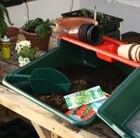
Potting station
£28.99 £22.99

Dibblet for the seed and plant spacing rule
£6.99 £5.99
|
|























